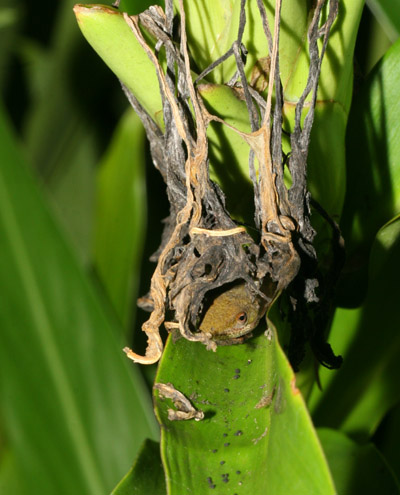 The nice thing about going long periods without rain is that scheduling photo outings isn’t difficult – provided you can cope with the heat. The recent rains have changed this quite a bit, and I’ve had to switch several student appointments around due to cruddy weather. This past Saturday, we watched the weather reports on practically an hourly basis and chanced a botanical garden outing in the morning before the rains were expected to hit – as it was, it started slowly just before we were to wrap up, and came down in earnest right after the session ended. So yeah, clean living and faith in Nothing and all that jazz…
The nice thing about going long periods without rain is that scheduling photo outings isn’t difficult – provided you can cope with the heat. The recent rains have changed this quite a bit, and I’ve had to switch several student appointments around due to cruddy weather. This past Saturday, we watched the weather reports on practically an hourly basis and chanced a botanical garden outing in the morning before the rains were expected to hit – as it was, it started slowly just before we were to wrap up, and came down in earnest right after the session ended. So yeah, clean living and faith in Nothing and all that jazz…
We didn’t escape the heavy overcast, though, making conditions so dark that handheld shots were haphazard at best, especially if one wanted a smaller aperture for more depth. I finally gave up and pulled out the flash unit, but since I was carrying my ‘instructor’ kit I didn’t have the macro bracket or softbox, so the flash was mounted on the camera hotshoe and the lighting is as harsh as a bright sunny day, completely belying the real conditions. Thus, this green anole (Anolis carolinensis) was actually in deep shade and, had it not moved when it did, I would have blown past it entirely, thinking it was a bud or something. Just in case it isn’t coming together for you, it’s facing towards us, slightly down and to image left – that’s the broad top of the head you’re seeing, with the rest of the body hidden within the leaves.
That wasn’t the only anole we spotted, either – two more were hanging out only a few meters away, this one in particular presenting an aged look, though I have no idea if this is the slightest bit accurate or not – I didn’t get close enough to see if it had long wiry hairs sprouting from its ears, a dependable sign. Well, okay, maybe that’s just human males…

 Many of the flowers were past their peak and showing it, so pollinator activity was limited, probably disappointing this minuscule crab spider who wasn’t doing a very good job of blending in – I’m not sure targeting the color-blind insects is the best strategy. I’ve been counting on the botanical garden to give me more opportunities for decent crab spider pics, and it’s been letting me down this year. Striking fear into the hearts of gnats is not what I’m after – show me something that can take down a bumblebee and we’ll talk.
Many of the flowers were past their peak and showing it, so pollinator activity was limited, probably disappointing this minuscule crab spider who wasn’t doing a very good job of blending in – I’m not sure targeting the color-blind insects is the best strategy. I’ve been counting on the botanical garden to give me more opportunities for decent crab spider pics, and it’s been letting me down this year. Striking fear into the hearts of gnats is not what I’m after – show me something that can take down a bumblebee and we’ll talk.
Another, also found on an aster bloom, did a much better job of hiding despite the color difference, because I didn’t see that one at all until I was editing the photos. However, it was so small in the frame, since I was aiming wider, that it is barely recognizable as an arthropod at all, much less making an interesting photo.
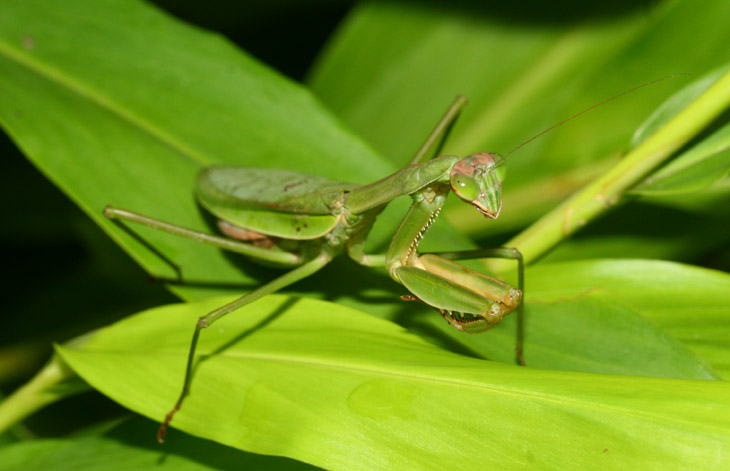
Yes, another mantis, also pregnant. This one was hanging out near the anoles, mocking me because neither her nor her kin could be seen where I’d predicted them to be found, a patch of Piedmont wildflowers that makes an ideal habitat for mantids. In the same area this past winter, I had found the egg case left by last year’s model, and vowed to keep an eye on it. However, it was on a plant stem that was cut back by the garden staff over the winter, and where it actually ended up I cannot say.
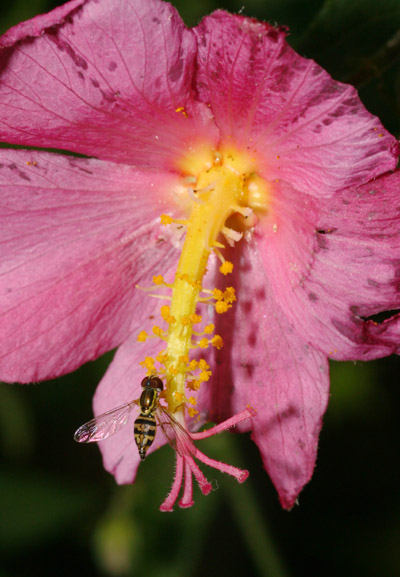 Like the anoles, you can pick your favorite hoverfly photo too, since I captured several while I was there; this is the first that will appear in the post. From the very distinctive abdominal markings I’m going to say this is a Toxomerus geminatus – if it’s not, it’s trying to look like one anyway and I won’t take the blame for that. The hoverflies were pretty much the only pollinators to be seen that morning and weren’t bothered by the fading glory of the blooms; I can’t say that I spotted one lepidopteran the entire time.
Like the anoles, you can pick your favorite hoverfly photo too, since I captured several while I was there; this is the first that will appear in the post. From the very distinctive abdominal markings I’m going to say this is a Toxomerus geminatus – if it’s not, it’s trying to look like one anyway and I won’t take the blame for that. The hoverflies were pretty much the only pollinators to be seen that morning and weren’t bothered by the fading glory of the blooms; I can’t say that I spotted one lepidopteran the entire time.
This particular syrphid, however, was in a very photogenic position as I approached but flew up from its perch as I closed to photographic range; I froze, and it returned to the same position – clean living and faith in Nothing and all that jazz. Even got a nice stained glass effect off the wings from the flash unit.
Small, stupid note: as I’ve often said before, the images are placed alongside the text in a manner where they appear to lead or point into the text. And while this fly is facing away, the flower – more prominent in the frame – is going in the opposite direction, so I went with this layout. If you disagree, text ‘INEPT’ to whatever number you like because I really don’t care…
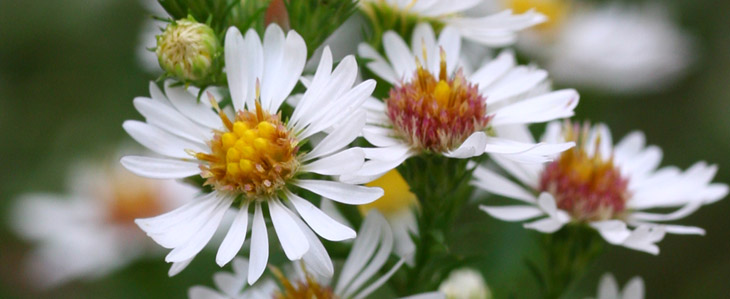
I needed another wide shot to break it up – see that layout thing above. This is one of the few I took without flash, and shows the lighting conditions a little more accurately. You can see that even the second flower is beginning to go soft due to its minimal distance from the lens, set at f4 because anything more would have induced motion blur from either the slight breeze or my movement.
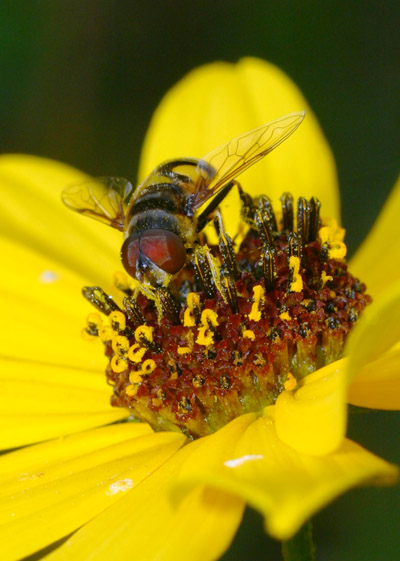 The other hoverfly shot, a bit more personal – I’m not even going to try to identify this one. It had paused while partaking of this maybe-daisy to clean the copious pollen from its legs, but three other frames were discarded because nailing the prime focus at this magnification eluded me. If you want to pursue macro work, aim for early mornings and very still days to at least minimize how much the plants (and thus the occupants thereof) wave in and out of your focus range. Note the petals, and how blurred they are front and back – focus range is very short, and even a mild breeze can bend a flower blossom far more than that.
The other hoverfly shot, a bit more personal – I’m not even going to try to identify this one. It had paused while partaking of this maybe-daisy to clean the copious pollen from its legs, but three other frames were discarded because nailing the prime focus at this magnification eluded me. If you want to pursue macro work, aim for early mornings and very still days to at least minimize how much the plants (and thus the occupants thereof) wave in and out of your focus range. Note the petals, and how blurred they are front and back – focus range is very short, and even a mild breeze can bend a flower blossom far more than that.

Another horizontal filler, this time an American beautyberry leaf (Callicarpa americana) against its own cluster of fruit – this is a very tight crop from the original to enhance the abstract nature. It also helps that the berries were out of focus, since they were also past their prime (note the variations in color,) and I never realized just how bad they smelled as they started to decay.
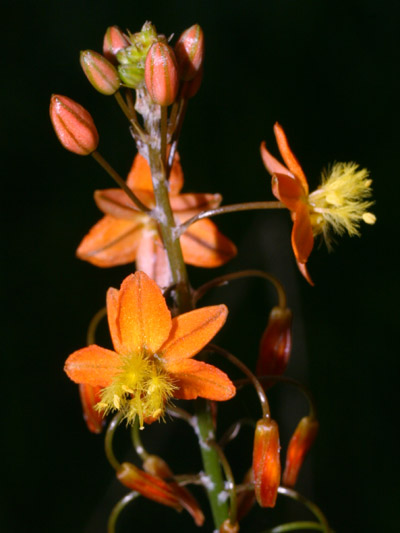 And one last one, because – once again having to be to the right of the text. I’m not going to try to identify these flowers, I just happened to like their layout and color. It might have been nice to be there on a brighter day and thus induce some brightness and color from the background as well, and not make these appear like they were photographed at night, but their own color might have had less impact then.
And one last one, because – once again having to be to the right of the text. I’m not going to try to identify these flowers, I just happened to like their layout and color. It might have been nice to be there on a brighter day and thus induce some brightness and color from the background as well, and not make these appear like they were photographed at night, but their own color might have had less impact then.
I’m running steadily behind on recent images and trying to catch up, so there will be another set coming soon. But first, an important message from our sponsor…




















































